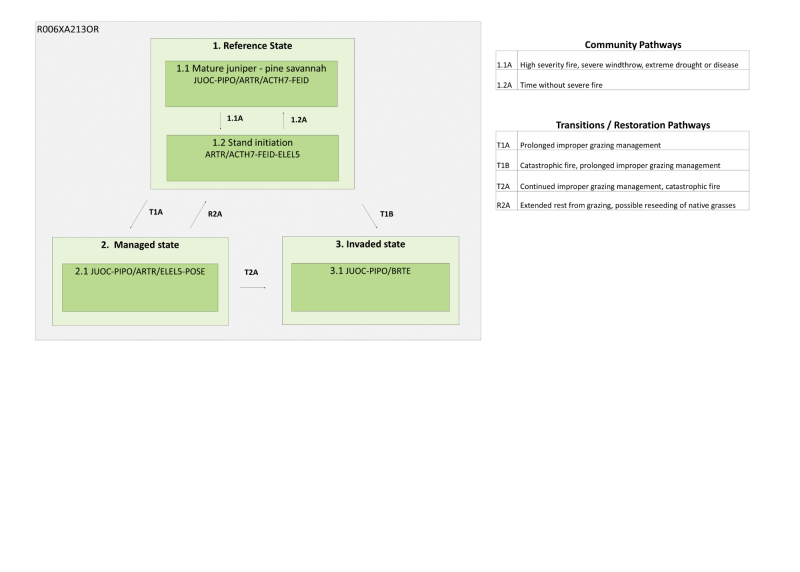
Natural Resources
Conservation Service
Ecological site R006XA213OR
Pumice Terrace 8-10 PZ
Last updated: 3/31/2025
Accessed: 12/19/2025
General information
Provisional. A provisional ecological site description has undergone quality control and quality assurance review. It contains a working state and transition model and enough information to identify the ecological site.
MLRA notes
Major Land Resource Area (MLRA): 006X–Cascade Mountains, Eastern Slope
Stretching from northern Washington to southern Oregon, MLRA6 encompasses the mountain slopes, foothills, elevated plateaus and valleys on the eastern slopes of the Cascade mountains. This MLRA is a transitional area between the Cascade Mountains to the west and the lower lying Columbia Basalt Plateau to the east. Situated in the rain shadow of the Cascade Crest, this MLRA receives less precipitation than portions of the cascades further west and greater precipitation than the basalt plateaus to the east. Geologically, the majority of the MLRA is dominated by Miocene volcanic rocks, while the northern portion is dominated by Pre-Cretaceous metamorphic rocks and the southern portion is blanketed with a thick mantle of ash and pumice from Mount Mazama. The soils in the MLRA dominantly have a mesic, frigid, or cryic soil temperature regime, a xeric soil moisture regime, and mixed or glassy mineralogy. They generally are moderately deep to very deep, well drained, and loamy or ashy. Biologically, the MLRA is dominated by coniferous forest, large expanses of which are dominated by ponderosa pine, Douglas-fir or lodgepole pine. Areas experiencing cooler and moister conditions include grand fir, white fir, and western larch while the highest elevations include pacific silver fir, subalpine fir and whitebark pine. Economically, timber harvest and recreation are important land uses in these forests. Historically, many of these forests would have experienced relatively frequent, low and mixed severity fire favoring the development of mature forests dominated by ponderosa pine or Douglas-fir. In the southern pumice plateau forests, less frequent, higher severity fire was common and promoted the growth of large expanses of lodgepole pine forests.
LRU notes
This unit is characterized by a landscape of basalt terraces, abandoned lakebeds and dunes where exceedingly dry ponderosa pine – western juniper forests occur. These forests are largely geographically confined to the Lost Forest Research Natural Area, and despite receiving less than 11 inches of annual precipitation, persist among a desert shrubland due to unique soil characteristics. Here, deep eolian deposits of ash and pumice increase water holding capacity relative to nearby soils. Geologically, these deposits are underlain by Pliocene basalt from the High Cascades volcanic province. Botanically, these forests share characteristics with other dry pine forests as well as the nearby shrub steppe. Common members include, antelope bitterbrush, big sagebrush, needle and thread grass, Indian ricegrass, creeping wildrye and granite prickly gilia. The climate of this unit is cool and very dry with a soil climate defined by a frigid temperature regime and an aridic moisture regime. The historical fire regime of this site is likely similar to other very dry ponderosa pine communities, with moderately frequent, low severity fire common.
Ecological site concept
This site represents a unique, very dry ponderosa pine (Pinus ponderosa) and western juniper (Juniperus occidentalis) woodland occurring within the Lost Forest Research Natural Area at the northwestern edge of the Great Basin. Dislocated from other ponderosa pine sites at the eastern foothills of the Cascades, the Lost Forest stands is in stark contrast to the adjacent sagebrush steppe landscape. Here deep eolian deposits of volcanic ash and pumice have created the conditions for ponderosa pine persistence despite receiving precipitation generally lower than is required for the species (Moir and Franklin 1974). The influence of ash in these soils increases water holding capacity and bolsters site resilience during drought, facilitating the survival of ponderosa pine. Of all sites mapped in the Lost Forest, this site is the most commonly occurring. In comparison to similar ecological sites found on terraces within this landscape, this site has moderately deep soils and therefore supports greater cover of ponderosa pine. Adjacent loamy sites with deep and very deep soils support even greater cover of ponderosa pine.
This is a provisional ecological site and is subject to extensive review and revision before final approval. All data herein should be considered provisional and contingent upon field validation prior to use in conservation planning.
Associated sites
| R006XA212OR |
Forested Sandy Loam 8-11 PZ Adjacent areas with deeper soils and more productive stands of ponderosa pine |
|---|---|
| R006XA214OR |
Forested Pumice Dunes 8-11 PZ Adjacent forested dunes |
| R006XA216OR |
Forested Shrubby Dunes 8-11 PZ Adjacent forested dunes |
| R006XA217OR |
Very Shallow Pumice Terrace 8-11 PZ adjacent very-shallow terraces |
Similar sites
| R006XA217OR |
Very Shallow Pumice Terrace 8-11 PZ Shallower soils, lower cover of ponderosa pine |
|---|---|
| R006XA212OR |
Forested Sandy Loam 8-11 PZ Deeper soils (deep or very deep vs moderately deep) |
| R006XA214OR |
Forested Pumice Dunes 8-11 PZ Higher slope angles, fewer frost-free days, lower cover of ponderosa pine |
Table 1. Dominant plant species
| Tree |
(1) Juniperus occidentalis |
|---|---|
| Shrub |
(1) Artemisia tridentata |
| Herbaceous |
(1) Achnatherum thurberianum |
Click on box and path labels to scroll to the respective text.
Ecosystem states
| T1A | - | Prolonged improper grazing management |
|---|---|---|
| T1B | - | Catastrophic fire, prolonged improper grazing management |
| R2A | - | Extended rest from grazing, possible reseeding of native grasses |
| T2A | - | Continued improper grazing management, catastrophic fire |
State 1 submodel, plant communities
| 1.1A | - | High severity fire, severe windthrow, extreme drought or disease |
|---|---|---|
| 1.1B | - | Time without severe fire |
